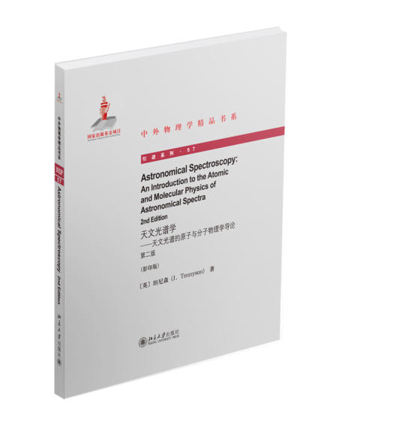《天文光譜學——天文光譜的原子與分子物理學導論(第二版)(英文影印版)》是2014年出版的圖書,作者是劉嘯。
基本介紹
- 書名:天文光譜學——天文光譜的原子與分子物理學導論(第二版)(英文影印版)
- 作者:劉嘯
- 出版社:北京大學出版社
- 出版時間:2014年12月29日
- 頁數:240 頁
- 定價:41 元
- 開本:16 開
- 裝幀:平裝
- ISBN:978-7-301-25170-6
- 版次:1
- 書號:25170
- 字數:240千字
- 叢書名:中外物理學精品書系
出版背景,章節目錄,
出版背景
對於宇宙的觀測,其信息幾乎都來自於光。觀測一方面要把光分解成各種成分,另一方面也要了解原子和分子的性質。本書對於這兩方面都進行了系統講述。在天文光譜學的研究中,本書能夠提供豐富而實用的知識。 本書適合天文學領域的研究者和研究生閱讀。
章節目錄
Preface v
1. Why Record Spectra of Astronomical Objects? 1
1.1 A Historical Introduction
1.2 What One Can Learn from Studying Spectra
2. The Nature of Spectra
2.1 Transitions
2.2 Absorption and Emission
2.3 Other Measures of Transition Probabilities
2.4 Stimulated Emission
2.5 Optical Depth
2.6 Critical Density
2.7 Wavelength or Frequency?
2.8 The Electromagnetic Spectrum
3. Atomic Hydrogen
3.1 Overview
3.2 The Schr ¨odinger Equation of Hydrogen-Like Atoms
3.3 Reduced Mass
3.4 Atomic Units
3.5 Wavefunctions for Hydrogen
3.6 Energy Levels and Quantum Numbers
3.7 H-Atom Discrete Spectra
3.8 H-Atom Spectra in Different Locations
3.9 H-Atom Continuum Spectra
3.10 Radio Recombination Lines
3.11 Radio Recombination Lines for Other Atoms
3.12 Angular Momentum Coupling in the Hydrogen Atom
3.13 The Fine Structure of Hydrogen
3.14 Hyperfine Structure in the H Atom
3.15 Allowed Transitions
3.16 Hydrogen in Nebulae
4. Complex Atoms
4.1 General Considerations
4.2 Central Field Model
4.3 Indistinguishable Particles
4.4 Electron Configurations
4.5 The Periodic Table
4.6 Ions
4.7 Angular Momentum in Complex Atoms
4.8 Spectroscopic Notation
4.9 Parity of the Wavefunction
4.10 Terms and Levels in Complex Atoms
5. Helium Spectra
5.1 He I and He II Spectra
5.2 Selection Rules for Complex Atoms
5.3 Observing Forbidden Lines
5.4 Grotrian Diagrams
5.5 Potential Felt by Electrons in Complex Atoms
5.6 Emissions of Helium-Like Ions
6. Alkali Atoms 81
6.1 Sodium
6.2 Spin-Orbit Interactions
6.3 Fine Structure Transitions
6.4 Astronomical Sodium Spectra
6.5 Other Alkali Metal-Like Spectra
7. Spectra of Nebulae
7.1 Nebulium
7.2 The Bowen Mechanism
7.3 Two Valence Electrons
7.4 Autoionisation and Recombination
8. Spectra in Magnetic Fields
8.1 Uniform Magnetic Field
8.2 Strong Magnetic Field
8.3 Weak Magnetic Field
8.4 Spectra in Magnetic Field
9. X-Ray Spectra
9.1 Inner Shell Processes
9.2 The Solar Corona
9.3 The Structure of Highly Ionised Atoms
9.4 Isotope Effects
10. Molecular Structure
10.1 The Born-Oppenheimer Approximation
10.2 Electronic Structure of Diatomics
10.3 Schr ¨odinger Equation
10.4 Fractionation
10.5 Vibration-Rotation Energy Levels
10.6 Temperature Effects
11. Rotational Spectra 157
11.1 Rotational Structure of Polyatomic Molecules
11.2 Selection Rules: Pure Rotational Transitions
11.3 Selection Rules
11.4 Isotope Effects
11.5 Rotational Spectra of Other Molecules
11.6 Rotational Spectra of Molecular Hydrogen
11.7 Maser Emissions
12. Vibration-Rotation Spectra
12.1 Vibrations in Polyatomic Molecules
12.2 Vibrational Transitions
12.3 Astronomical Spectra
13. Electronic Spectra of Diatomic Molecules
13.1 Electronic Transitions
13.2 Selection Rules
13.3 Transition Frequencies
13.4 Astronomical Spectra
13.5 Non-1_ Electronic States
Solutions to Model Problems
Further Reading and Bibliography
Index

